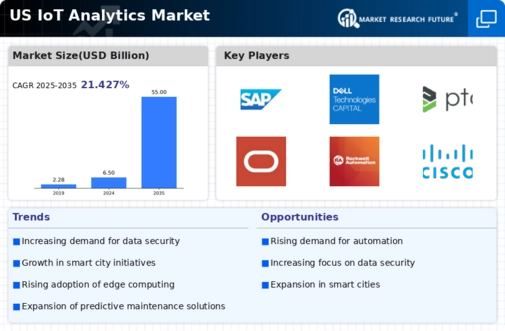The US IoT Analytics Market is rapidly evolving, driven by the increasing penetration of connected devices across various sectors including manufacturing, healthcare, and smart cities. In this competitive landscape, firms are striving to leverage data analytics to derive actionable insights from the vast amounts of data generated by IoT devices. The market is characterized by the involvement of both established technology giants and innovative startups, each aiming to capture a share of the expanding market.
Strategic partnerships, mergers and acquisitions, and technological advancements are prevalent strategies employed by the key players in the market, ensuring a dynamic environment where companies are consistently enhancing their product offerings to meet the growing demand for advanced analytics solutions.In the context of the US IoT Analytics Market, SAP has established a commanding presence by offering a robust suite of analytics solutions tailored for IoT applications.
The company's strength lies in its comprehensive data management and analytics capabilities, which empower organizations to streamline operations and gain real-time insights. With a strong focus on innovation, SAP has leveraged its extensive experience in enterprise resource planning and data analytics to create efficient IoT frameworks, enhancing its competitive edge. The company also invests significantly in research and development to enhance its product capabilities and maintain relevance in a rapidly changing technological landscape.
Furthermore, SAP ensures customer engagement through extensive training and support, solidifying its long-standing reputation as a reliable partner in analytics solutions.GE, specifically in the context of the US IoT Analytics Market, presents a stronghold with its focus on industrial IoT applications through its GE Digital arm.
The company offers key products such as Predix, which is an IoT platform designed for industrial applications, enabling organizations to visualize and analyze data for better decision-making. GE's strengths lie in its deep understanding of manufacturing and industrial sectors, making it a preferred choice for organizations seeking targeted analytics solutions. The company has actively engaged in mergers and acquisitions to bolster its technological capabilities and expand its market influence. Such strategic moves facilitate the integration of advanced analytics with existing technologies, thus enhancing its value proposition in the market.
GE's commitment to innovation and its strong market presence underscore its position as a key player in the US IoT Analytics Market, driving forward with initiatives that address both current and future demands in the sector.






















